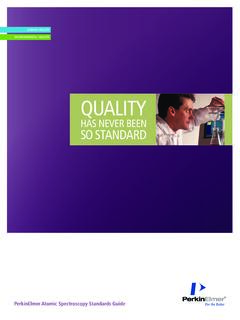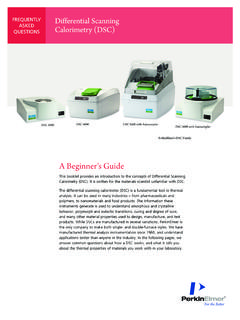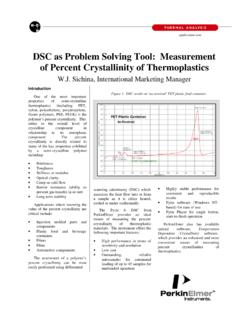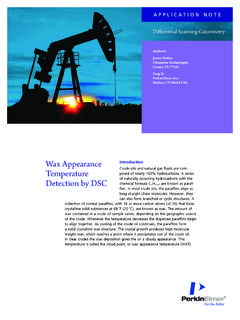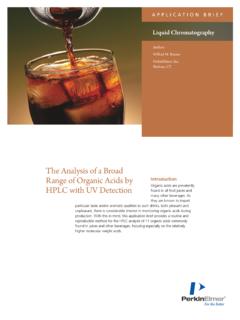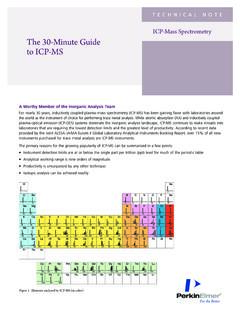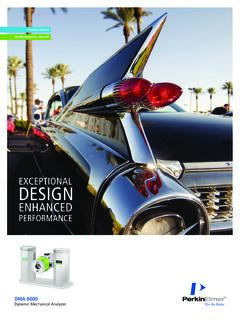Transcription of Analysis of Wastewater for Metals using ICP-OES
1 A p p l i c at i o n N o t e ICP-Optical Emission Spectroscopy Authors Praveen Sarojam, PerkinElmer, Inc. Shelton, CT 06484 USA. Analysis of Introduction The Analysis of Wastewater for trace metal contamination is an Wastewater important step in ensuring human and environmental health. Wastewater is regulated differently in different countries, but the for Metals goal is to minimize the pollution introduced into natural waterways. In the , the Environmental Protection Agency (EPA), in conjunction using ICP-OES with the states, negotiates a discharge permit through the National Pollutant Discharge Elimination System (NPDES) which takes into account the federal guidelines for the industrial category (40 CFR, Parts 405-471)1 and the sensitivity of the waterway receiving the discharge.
2 Therefore, Wastewater may need to be measured for a variety of Metals at different concentrations, in different Wastewater matrices. A variety of inorganic techniques can be used to measure trace elements in waste water including atomic absorption spectroscopy (AAS), inductively coupled plasma optical emission spectroscopy ( ICP-OES ) and ICP mass spectrometry (ICP-MS). Depending upon the number of elements that need to be determined and the number of samples that need to be run, the most suitable technique for business requirements can be chosen. ICP-OES is a good match with the productivity requirements of many laboratories and requires only a moderate investment.
3 The EPA has developed two methods for Wastewater The ICP torch is physically mounted in an axial orientation Analysis using ICP-OES , Method and Method ,3 in the instrument's shielded torch box, but can be viewed Method was developed after the initial introduction either axially or radially. The view mode is user-selectable on of axial technology and gives more specific guidance for an element-by-element basis. A shear gas flow (compressed axial use. The methods have numerous quality control air) provides elimination of the cool plasma tail to allow requirements (Table 1) to ensure proper instrument and direct observation of the plasma's normal analytical zone, methodology operation during the Analysis of Wastewater thus minimizing chemical matrix effects when the axial-view samples.
4 The full suite of analytes listed in the method will mode is employed. be measured and quality control applied although the list of Metals regulated in the effluent measured here, from The sample introduction unit consisted of a cyclonic spray the automobile industry, would be a subset. For example, chamber and a low flow GemCone nebulizer. The cyclonic elements specified for measurement in 40 CFR, Part 433, spray chamber ensures high sample transfer to the plasma metal finishing point source category, include cadmium, and fast rinse in and out times, which improves productivity.
5 Chromium, copper, lead, nickel, silver, and zinc and may The low flow GemCone nebulizer permits lower nebulizer cover some automobile manufacturing processes. gas flow rates, useful for spectral lines with high excitation energies and for providing more robust plasma, which is essential for waste water samples. Experimental Instrumentation The read time was set for a variable range from 2 s to 5 s using the auto-integration mode. This feature will take a The measurements were performed using the PerkinElmer snapshot of the intensities of various lines to be measured Optima 7300 DV ICP-OES instrument (PerkinElmer, Inc.)
6 Before the actual reading begins. For high intensities, the Shelton, CT, USA) equipped with WinLab32 for ICP short read time will be used, while for low intensities, the Version software for simultaneous measurement of all larger time will be used and thereby increasing the sample analyte wavelengths of interest (Figure 1). The Optima 7300 throughput. Long read times reduce the effects of shot DV has been optimized to provide high speed Analysis . By noise and are beneficial in obtaining lower detection limits combining an SCD detector and an echelle optical system, (See Table 2 for detailed optimized instrument parameters).
7 The Optima 7300 DV can measure all elements simultaneously. Its wavelength flexibility allows the end users to easily add new elements as their program needs change. Table 1. EPA Method Requirements. Check Code Check Name Purpose Frequency of Check Specified Limits CCB Continuing Calibration Checks calibration validity After calibration, after <IDL. Blank every 10 analyses and at the end of analyses LRB Laboratory Reagent Blank Checks the laboratory reagents 1 per batch < *MDL. and apparatus for possible contamination LFB Laboratory Fortified Blank Checks the analyte recovery 1 per batch 85-115% recovery of a spiked blank LFM Laboratory Fortified Matrix Checks the analyte recovery 10 % of total samples 85-115% recovery in sample matrix QCS Quality Control Standard Checks the accuracy of the Post calibration 95-105% recovery calibration by analyzing a second source standard IPC Instrument Performance To check the accuracy and Every 10 analyses and at 95-105% immediately after Check drift by analyzing a standard the end
8 Of analyses calibration, 90-110% thereafter as sample SIC Spectral Interference Check Checks the presence of Periodically No criteria specified spectral interferences CRM Certified Reference Material Checks the accuracy of the Immediately after Should be analyzed whenever developed method calibration available 2. Table 2. Optima 7300 DV Operating Conditions. Table 3. Calibration Standards and Spike Concentration. Plasma gas flow 15 L/min Element Calibrated up to Spike Concentration Auxillary gas flow L/min (mg/L) (mg/L). Nebulizer gas flow L/min Aluminum RF power 1450 watts Antimony Plasma view Axial or Radial Arsenic Read delay 90 sec Barium Read parameters (s)
9 Min, max Beryllium Peristaltic pump flow rate mL/min Boron Spray chamber Cyclonic Cadmium Nebulizer Low flow GemCone Calcium Injector Alumina, mm Chromium Sample tubing Standard mm Cobalt Drain tubing Standard mm Copper Quartz torch Single slot Iron Sample capillary Teflon 1 mm Lead Replicates 3 Lithium Magnesium Resolution Normal Manganese Molybdenum Nickel Phosphorus Potassium Selenium Silicon Silver Sodium Strontium Thallium Figure 1. PerkinElmer Optima 7300 DV ICP-OES . Tin Titanium Vanadium The PerkinElmer S10 Autosampler was used for high Zinc throughput and automated Analysis .
10 The autosampler automates standard and sample introduction for instru- ment calibration and sample Analysis . Table 4. Combinations of Multi-element Standards Used. Standard Elements Standards, Chemicals and Certified Reference Material STD 1 Al, As, Ba, Be, Cd, Ca, Cr, Co, Cu, Fe, Pb, Li, Mg, PerkinElmer NIST traceable quality control standards for Mn, Ni, K, Se, Ag, Na, Sr, Tl, V, Zn ICP or ICP-MS (N9300233, N9300234 and N9300235) were STD 2 B, Mo, P, Si, Ti used as the stock standards for preparing working standards. STD 3 Sb, Sn A total of three standards were used for calibration with each metal ion represented by one standard (Tables 3 and 4).

